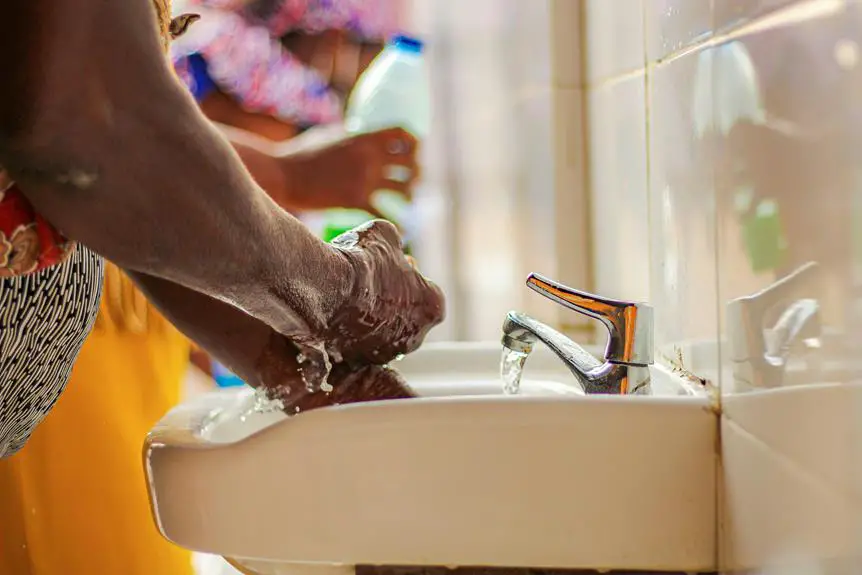If you're looking to give your apparel a unique twist, acid washing can be an effective technique. You'll want to start with the right materials and ensure your workspace is well-ventilated. Mixing a bleach solution and applying it carefully can yield striking results, but timing is crucial to avoid over-bleaching. As you explore this method, consider the effects you want to achieve and the best practices for safety. Knowing how to care for your finished pieces can make all the difference, especially when it comes to longevity and appearance. So, what's the next step in mastering this technique?
Table of Contents
Key Takeaways
- Prepare the fabric by pre-washing it with warm water and mild detergent to ensure it is clean and dry before acid washing.
- Use a 1:1 ratio of bleach and water in a spray bottle for controlled application of the acid solution.
- Apply the acid solution evenly and monitor the fabric to achieve the desired distressed look without over-processing.
- Rinse the fabric thoroughly with water after achieving the desired effect to neutralize the acid and stop the bleaching process.
Understanding Acid Wash Technique
Acid wash is a popular technique that involves using a chemical solution to create a faded, distressed look on fabric. You'll often see this method used on denim, giving it a unique, vintage aesthetic that many people love. To achieve this effect, you'll typically use a mix of bleach or other chemicals that alter the color and texture of the fabric.
When you apply acid wash, it's crucial to work in a well-ventilated area. Safety is key, so don't forget to wear gloves and protective eyewear. You'll want to prepare your fabric by washing it first, ensuring it's free from dirt and oils that could affect the outcome.
After that, you can spray or dip your fabric into the solution, concentrating on specific areas for a more controlled look. Remember, the longer the fabric sits in the solution, the more faded it becomes, so keep an eye on it.
Once you're satisfied with the look, rinse it thoroughly to stop the bleaching process. Dry it properly, and you've got yourself a custom piece that stands out!
Materials Needed for Acid Washing
To get started with acid washing, you'll need a few essential materials that will help you achieve the perfect distressed look on your apparel.
First, gather a pair of gloves to protect your hands from harsh chemicals. You'll also need a spray bottle to easily apply the acid solution to your fabric. An acid like chlorine bleach is crucial, but make sure to mix it with water in a well-ventilated area.
You'll want to have a bucket or a large plastic container to safely hold your apparel while soaking. For best results, choose cotton or denim items, as these fabrics respond well to the acid wash. Additionally, old towels or rags will come in handy for cleanup afterward.
Don't forget to grab a mask and goggles to shield yourself from any fumes. A plastic tarp or drop cloth will protect your workspace from spills.
Lastly, a brush or sponge can help you control the application and create unique patterns. With these materials ready, you're all set to dive into the acid washing process and customize your apparel!
Preparing Your Apparel
Before you start acid washing, it's essential to choose the right fabrics, as some materials react better than others.
Don't forget to pre-wash your items to remove any finishes that could interfere with the acid wash process.
Lastly, make sure to take safety precautions to protect yourself while working with chemicals.
Selecting Suitable Fabrics
Choosing the right fabric is crucial for achieving the best results with acid wash techniques. You'll want to pick materials that can withstand the chemical process without falling apart or losing their shape.
Cotton is a top choice because it absorbs the acid well, allowing for that unique faded look you're after. Blends like cotton-polyester can also work, but be cautious—too much synthetic fiber can prevent the acid from reacting properly.
Avoid delicate fabrics like silk or wool, as they can easily get damaged and won't give you the desired effect. Additionally, the weight of the fabric matters; heavier materials tend to create more dramatic results, while lighter fabrics mightn't yield the same intensity.
Consider pre-washed denim or other garments that already have some wear, as these will take the acid wash more effectively. Ultimately, your choice of fabric can make or break your acid-washed project, so take the time to choose wisely.
Experiment with a few different types if you're unsure, and embrace the learning curve. The right fabric will elevate your customization game and give you stunning results.
Pre-Washing Techniques
Pre-washing your apparel helps remove any finishes or coatings that could interfere with the acid wash process.
Start by gathering all the items you plan to customize. You'll want to use warm water and a mild detergent to ensure your fabric is clean and ready for the acid treatment.
Toss your apparel into the washing machine, and select a regular cycle. This will help eliminate any chemicals, like sizing or softeners, that may have been added during manufacturing. If you're working with denim, it's especially important to pre-wash, as this helps avoid unwanted patches during the acid wash.
After the wash cycle, dry your apparel in the dryer or hang it up to air dry. Ensure everything is completely dry before you start the acid wash process. This step is crucial, as any leftover moisture can dilute the acid, leading to uneven results.
Safety Precautions Required
Once your apparel is clean and dry, it's important to prioritize safety precautions to protect yourself and your workspace during the acid wash process.
First, wear protective gear, including gloves, goggles, and a mask. Acid can irritate your skin and eyes, so don't skip these essentials.
Next, choose a well-ventilated area for your project. Working outdoors is ideal, but if that's not possible, make sure your workspace has plenty of airflow. Open windows and use fans to keep the air circulating.
Also, keep all materials organized and within reach. This includes your acid solution, spray bottles, and any tools you'll need. If you spill any acid, clean it up immediately with water to prevent damage to surfaces or potential harm to yourself.
Step-by-Step Acid Washing Process
To get started with the acid washing process, you'll need to gather all the necessary materials.
Once you have everything ready, prepare the fabric for treatment.
After that, it's time to apply the acid and see your creative vision come to life.
Gather Necessary Materials
Before diving into the acid wash process, you'll need to gather several essential materials to ensure your project goes smoothly.
First, you'll need a piece of clothing—denim works best, but cotton blends can also yield great results.
Next, grab a spray bottle for applying the acid solution. You'll also require a pair of gloves to protect your hands from the chemicals.
For the acid solution, you can use bleach or a commercial acid wash product. If you opt for bleach, make sure it's diluted with water in a 1:1 ratio. Additionally, having a bucket or basin on hand is vital for mixing your solutions.
You might want to use a mask to avoid inhaling fumes while working. Also, consider having some old rags or paper towels nearby for any spills or drips. Lastly, a drop cloth or plastic sheet can protect your workspace from any accidental splashes.
Once you've gathered these materials, you'll be ready to move on to the next steps in the acid wash process, where you'll prepare your fabric for customization.
Prepare the Fabric
Start by washing the fabric to remove any dirt or finishes that might interfere with the acid wash process. This ensures that the acid can penetrate evenly and create the desired effect.
After washing, follow these steps to prepare your fabric effectively:
- Choose Your Fabric: Select 100% cotton or cotton blends for the best results. Synthetic fabrics may not react well with acid.
- Dry the Fabric: Allow the fabric to completely dry after washing. This prevents excess moisture from diluting the acid solution.
- Iron If Necessary: If your fabric is wrinkled, iron it out. A smooth surface makes it easier to apply the acid evenly.
- Cut or Fold: Decide how you want to customize your fabric. Cut it into pieces or fold it creatively to achieve unique patterns during the acid wash.
Once you've completed these steps, your fabric will be ready for the next phase of the acid washing process.
Proper preparation is key to achieving the best results, so take your time with each step!
Apply the Acid
Now, it's time to mix your acid solution and get ready to transform your fabric with an eye-catching design. Start by wearing gloves and a mask to protect yourself from the fumes. In a well-ventilated area, combine one part bleach with three parts water in a spray bottle or bucket.
Once your solution is ready, lay your prepared fabric on a flat surface. If you want a specific pattern, consider using stencils or rubber bands to create sections that won't be bleached. Then, using a spray bottle or sponge, apply the acid solution evenly over the fabric. For a more dramatic effect, you can also dip sections directly into the solution.
Let the acid sit for about 5 to 20 minutes, depending on how intense you want the color change to be. Keep an eye on it, as the process can happen quickly. When you're satisfied with the look, rinse the fabric thoroughly in cold water to stop the bleaching process.
Tips for Achieving Desired Effects
To achieve your desired effects with acid wash, experiment with different dilution ratios of the solution to control the intensity of the distressing. A more concentrated solution will yield bolder results, while a diluted mix can create subtle fades.
Here are some tips to help you get the look you want:
- Test on Scraps: Before applying to your main piece, practice on fabric scraps. This lets you see how the material reacts to the acid wash.
- Apply Evenly: Use a spray bottle or sponge to apply the solution evenly. This helps prevent uneven patches and gives a more uniform appearance.
- Timing is Key: Keep an eye on the fabric while it's soaking in the solution. Check every few minutes to avoid over-processing, as the acid can weaken the fibers.
- Rinse Thoroughly: Once you've achieved the desired effect, rinse the fabric thoroughly with water to neutralize the acid. This step is crucial for preserving the longevity of your customized apparel.
Safety Precautions to Consider
When working with acid wash, it's essential to prioritize safety by wearing protective gear, including gloves and goggles, to shield yourself from harmful chemicals. Acid can cause skin irritation and eye damage, so don't skip on these basics.
Make sure you work in a well-ventilated area. The fumes from the acid can be potent, and you don't want to inhale them. Ideally, set up your workspace outdoors or use a fan to circulate air if you're working indoors.
Keep a first aid kit handy, just in case. Familiarize yourself with the materials you're using and know how to treat any potential injuries. If you accidentally spill acid on your skin, rinse it off immediately with plenty of water and seek medical attention if necessary.
Store your acid wash solutions securely, out of reach of children and pets. Always label your containers to prevent any mix-ups.
Lastly, clean up thoroughly after your project. Dispose of any used materials safely, following local regulations. By taking these precautions, you can enjoy customizing your apparel while minimizing risks.
Caring for Acid-Washed Clothing
Caring for acid-washed clothing requires special attention to maintain its unique look and prevent damage over time. You want to ensure your pieces stay vibrant and stylish. Here are some key tips to help you care for your acid-washed apparel:
- Wash in Cold Water: Always opt for cold water when washing your acid-washed clothing. This helps preserve the colors and prevents fading.
- Use Gentle Detergents: Choose mild detergents that are free from bleach or harsh chemicals. These can strip away the unique acid-washed effect.
- Air Dry: Instead of tossing your items in the dryer, air dry them. Hanging them up helps maintain their shape and reduces the risk of damage.
- Store Properly: When storing your acid-washed pieces, avoid folding them; instead, hang them to prevent creasing and maintain their original form.
Frequently Asked Questions
Can I Use Acid Wash on Different Fabric Types?
Yes, you can use acid wash on different fabric types, but results vary. Cotton works best, while blends may not react as strongly. Always test a small area first to see how the fabric responds.
How Does Acid Wash Differ From Bleach?
Acid wash uses a chemical process to create a faded look, while bleach simply lightens fabric. You'll notice acid wash maintains some color depth, whereas bleach often results in a more uniform, lighter shade.
Will Acid Washing Affect the Fabric's Durability?
Yes, acid washing can affect a fabric's durability. It weakens fibers, making them more prone to wear and tear. However, if done correctly, you can achieve a stylish look without severely compromising your garment's lifespan.
Can I Customize the Acid Wash Pattern?
Yes, you can customize the acid wash pattern! By varying the application technique, using stencils, or controlling the exposure time, you'll create unique designs that reflect your personal style and creativity. Experiment and enjoy!
How Long Do Acid-Washed Effects Last?
Acid-washed effects can last for years if properly cared for. Washing in cold water and air drying helps preserve the look. Just remember, the more you wash, the more the effect may fade over time.
- How Does Ring Spun Cotton Affect Garment Fit and Shape Retention? - August 13, 2024
- What Are the Challenges in Producing Ring Spun Cotton? - August 13, 2024
- Is Ring Spun Cotton Suitable for Plus-Size Clothing? - August 13, 2024





